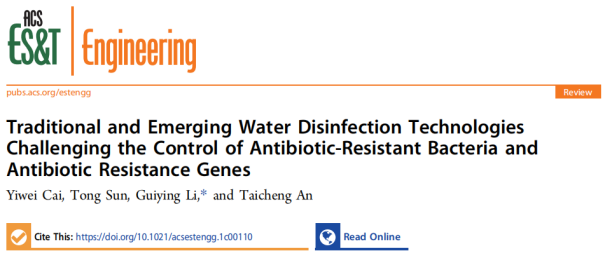近日,广东工业大学环境健康与污染控制研究院、环境科学与工程学院安太成教授团队题为《Traditional and Emerging Water Disinfection Technologies Challenging the Control of Antibiotic-Resistant Bacteria and Antibiotic Resistance Genes》的综述性论文在ACS ES&T Engineering (https://doi.org/10.1021/acsestengg.1c00110)杂志上接受发表。论文的第一作者为博士研究生蔡仪威,第二作者为硕士研究生孙彤,通讯作者为李桂英教授。该综述全面系统地阐述了污水消毒领域的抗生素耐药菌和耐药基因的去除与控制的最新研究进展和所面临的挑战。系统总结和分析了传统和新兴水消毒技术在去除耐药菌和耐药基因方面的应用进展与细菌的灭活机理。另外,重点关注和强调了消毒技术对耐药基因水平转移的影响并阐明其内在机制,为消毒技术的改良与优化、消毒对耐药基因转移的影响和控制环境中抗生素耐药性的传播等方面均提出了新的见解和观点。

环境中抗生素耐药菌(ARB)和抗生素耐药基因(ARGs)的出现给抗生素治疗传染病造成了巨大的障碍。污水处理厂作为ARB和ARGs的一个收纳库,其潜在的风险不容忽视。污水处理厂设有专门的消毒程序来对目标水体进行消毒,目的是消除水体中的病原微生物。然而,ARGs通常会被忽视,导致水处理过程中的ARGs可能进而通过水平基因转移将耐药性进行传播和发展。本文系统地综述了不同传统和新兴消毒技术在去除ARB和ARGs方面的应用进展,重点阐述了氯化、臭氧化、紫外辐射、太阳光、太阳光-DOM以及光催化或光电催化等方面的细菌灭活机理。另外,本文重点总结和分析了不同消毒技术对水环境中ARGs转移的影响并阐明了其重要内在机制。通过细菌灭活机制的梳理阐释了SOS响应、细胞膜的通透性可能是ARGs接合、转化和转导过程的关键过程。最后根据传统和新兴消毒技术在去除和控制ARB和ARGs方面的应用和当前存在的问题,提出了当前该技术所面临的挑战和机遇,指出了控制ARGs传播和扩散是相关领域的未来重要研究方向。
论文DOI:https://doi.org/10.1021/acsestengg.1c00110
图文摘要:

英文题目:Traditional and Emerging Water Disinfection Technologies Challenging the Control of Antibiotic-Resistant Bacteria and Antibiotic Resistance Genes
论文内封面:

英文摘要:
The emergence of antibiotic-resistant bacteria (ARB) and antibiotic resistance genes (ARGs) in the environment has created obstacles when treating infectious diseases with antibiotics. Wastewater treatment plants (WWTPs) serve as reservoirs for ARB and ARGs and can disseminate them into the environment. It is important to understand and address these risks. Generally, professional disinfection processes have been used in WWTPs to disinfect the target water body, with the goal of eliminating pathogenic microorganisms in the water. However, ARGs are not generally considered, and antibiotic resistance has spread and developed through horizontal gene transfer(HGT). This Review provides a detailed overview of the application progress of different traditional and new disinfection technologies in removing ARB and ARGs, mainly focusing on the bacterial inactivation mechanisms of chlorination, ozonation, ultraviolet (UV) (including UVA, UVB, and UVC), sunlight, sunlight-dissolved organic matter (DOM), and photocatalysis (PC)/photoelectrocatalysis (PEC). In addition, this Review also focuses on the disinfection technology involved in the transfer of ARGs and clarifies the underlying transfer mechanisms in water environments. Furthermore, by linking the mechanisms of bacterial inactivation, the Review describes how SOS response and cell membrane permeability may be the key step in the conjugation, transformation, and transduction of ARGs. Finally, given the applications and current problems associated with traditional water disinfection technologies and light-based disinfection technologies in removing and controlling ARB and ARGs, this Review describes the current challenges and opportunities to facilitate the development of future disinfection technologies. The Review also highlights future research directions related to ARG transmission control.
项目资助:本研究受到国家自然科学基金项目(U1901210,41573086),粤桂联合基金重点项目(2020B1515420002),广东省重点研发计划项目(2020B1111350002)和广东省本土创新科研团队项目(2017BT01Z032)的资助。